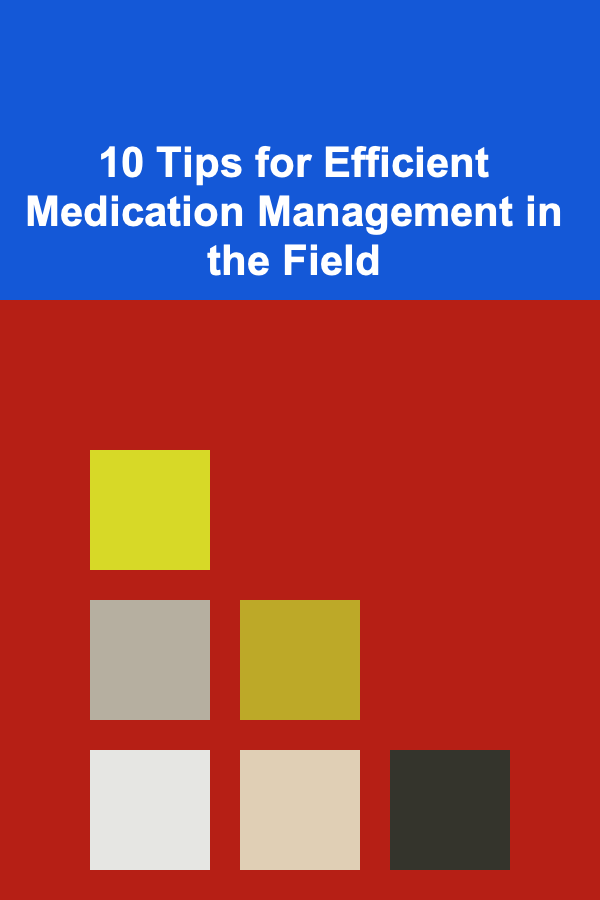
10 Tips for Efficient Medication Management in the Field
ebook include PDF & Audio bundle (Micro Guide)
$12.99$10.99
Limited Time Offer! Order within the next:

In healthcare, effective medication management is one of the most critical components in ensuring patient safety and therapeutic efficacy. This is especially true in the field, where healthcare providers work in less-than-ideal conditions, such as emergency response teams, rural clinics, and during international humanitarian missions. In these settings, proper medication management can save lives, improve patient outcomes, and prevent dangerous complications.
This article offers 10 practical tips for ensuring efficient medication management in the field. These strategies will help healthcare providers navigate the challenges of working in environments that may lack advanced medical infrastructure, and offer practical advice for safeguarding both the integrity of medications and patient health.
Assess the Scope of Medical Needs and Prioritize
Before embarking on a field mission, it's crucial to have a thorough understanding of the medical needs of the population you will be serving. Different environments may present varying health risks, and medications should be tailored to meet the most pressing needs of the community.
- Identify Common Conditions: Prioritize medications for conditions that are most likely to affect the population. For example, in disaster zones, pain relief, antibiotics, and wound care products may be prioritized, while in rural areas, chronic conditions like hypertension or diabetes may require more attention.
- Assess Available Resources: Know what medications you already have access to and what additional medications may be required. If you're working in an underserved area, it's essential to understand the limitations of the local healthcare infrastructure, which may lack access to pharmacies or specific medications.
Proper assessment helps avoid medication shortages and ensures the most effective treatments are available.
Organize and Label Medications Clearly
Field environments are often chaotic and fast-paced, making clear organization of medications essential for efficiency and safety. Disorganized storage can lead to confusion, dosing errors, and delays in treatment.
- Use Clear Labeling: Ensure that all medications are labeled with essential information, including the medication name, dosage, expiration date, storage requirements, and any specific instructions. This will minimize the risk of errors, especially when different staff members are involved in treatment.
- Group Medications by Category: Organize medications based on their use (e.g., antibiotics, analgesics, antihypertensives) to facilitate quicker access when treating patients. Use color-coded labels or containers to make the process even more efficient.
A well-organized medication storage system allows healthcare providers to act quickly, especially in high-pressure situations.
Keep Track of Expiration Dates
Medication expiration dates are often overlooked in the field, but using expired medications can be dangerous and may lead to ineffective treatment or adverse reactions.
- Implement a First-In, First-Out (FIFO) System: When stockpiling medications, make sure that the medications with the earliest expiration dates are used first. This will prevent medications from sitting on shelves past their expiration dates.
- Regularly Check Expiry Dates: As part of routine medication management, always check expiration dates before usage. A simple routine of inspecting medication boxes or containers can ensure that expired products are disposed of in a safe and timely manner.
By managing expiration dates carefully, you can prevent medical errors that stem from using outdated drugs.
Ensure Proper Storage Conditions
In the field, environmental factors like temperature, humidity, and light exposure can significantly affect the potency and safety of medications. Medications often require specific storage conditions to maintain their efficacy.
- Use Insulated Containers: Some medications, like vaccines or insulin, require refrigeration. In situations where a refrigerator isn't available, consider using portable insulated containers that can keep medications cool for several hours.
- Protect from Sunlight: Many medications degrade when exposed to direct sunlight. Ensure that medications are stored in dark, cool, and dry places to prevent degradation.
- Temperature Monitoring: Use temperature monitoring devices to keep track of the environment in which medications are stored. This can help ensure that medications like vaccines remain at the correct temperature.
By controlling storage conditions, you protect the integrity of medications, ensuring that they are safe and effective for use.
Maintain Accurate Inventory Records
One of the most common challenges in field medication management is keeping track of inventory. Without proper inventory management, there is a risk of running out of essential medications or overstocking unnecessary ones.
- Create an Inventory System: Use simple tools like spreadsheets, or specialized apps designed for medication management, to keep an accurate record of medications in stock. This should include the name of the medication, quantity, batch number, expiration date, and storage location.
- Perform Regular Audits: Regularly check and update your inventory to ensure that medications are adequately stocked and have not expired. Consider having a designated team member responsible for inventory management.
An up-to-date inventory system ensures that you're always prepared to meet the medical needs of your patients without running out of essential medications.
Educate Field Personnel on Medication Management
In the field, healthcare workers may have varying levels of training and expertise. Ensuring that all personnel are properly trained on medication management practices is crucial to preventing errors and improving patient care.
- Training on Medication Administration: Conduct regular training sessions to educate personnel on the proper handling, storage, and administration of medications. This should include understanding the specific medications in use, potential side effects, and contraindications.
- Clear Guidelines: Provide clear, easy-to-follow guidelines for medication administration, including when and how to give medications, common side effects, and actions to take in the event of a medication error.
Educating your team ensures that everyone is on the same page, minimizing errors and improving patient outcomes.
Adopt Digital Solutions for Medication Management
Technology can significantly enhance the efficiency and safety of medication management, even in remote or under-resourced settings.
- Mobile Apps: Several mobile apps can help with medication management in the field. These apps can track inventory, set reminders for medication administration, and provide guidelines on specific drugs. For example, some apps allow users to scan barcodes to check medication details quickly.
- Electronic Health Records (EHR): Use EHR systems to track patient medications, allergies, and treatment plans. This can reduce the risk of prescription errors and ensure that each patient's medication history is documented and accessible.
Digital solutions can streamline medication management processes, even in challenging environments.
Implement Clear Communication Channels
In field settings, especially in disaster response or humanitarian missions, communication breakdowns can lead to delays or errors in medication administration. Establishing clear communication channels between team members is essential for effective medication management.
- Daily Briefings: Hold regular team meetings or briefings to discuss patient needs, updates on medication usage, and any supply shortages or issues. This ensures everyone is aware of the current status of medication stock and patient needs.
- Cross-Check Prescriptions: Encourage team members to double-check medication orders and prescriptions to avoid errors. A second set of eyes can often catch issues before they become problems.
Efficient communication helps ensure that medication management remains a collaborative effort and that no one misses critical details.
Prepare for Emergencies and Stock Emergency Medications
Emergencies are a part of any field operation, and having the right medications on hand is crucial for providing immediate care in these situations.
- Stock Emergency Medications: Ensure that you have a stock of common emergency medications, such as epinephrine for anaphylactic reactions, naloxone for opioid overdoses, and anti-seizure medications. These should be stored separately and easily accessible.
- Have a Protocol for Emergency Drug Administration: Develop protocols for handling medical emergencies in the field, including medication dosages, administration methods, and what to do in case of a medication error.
Being prepared for emergencies can mean the difference between life and death in field settings.
Establish a Medication Disposal Protocol
Proper disposal of medications that are no longer needed or have expired is a vital part of maintaining a safe environment in the field. Incorrect disposal can lead to contamination or misuse.
- Disposal Containers: Use certified disposal containers for unused or expired medications. These should be placed in secure areas to prevent unauthorized access.
- Follow Local Regulations: Always follow local regulations for the disposal of hazardous materials, including medications. In some areas, special arrangements may need to be made for the disposal of drugs, especially controlled substances.
By having a clear disposal protocol, you can minimize the risks associated with improperly discarded medications.
Conclusion
Efficient medication management in the field requires careful planning, organization, and communication. Whether you're working in disaster zones, remote clinics, or international humanitarian missions, applying these 10 tips will help you provide the best possible care under challenging circumstances. By prioritizing medication safety, tracking inventory, educating personnel, and implementing proper storage and disposal methods, healthcare providers can ensure that medications are used effectively, and patient outcomes are maximized, even in the most challenging environments.
Reading More From Our Other Websites
- [Hiking with Kids Tip 101] Trail-End Treats: Family‑Friendly Coffee Stops Worth the Hike
- [Ziplining Tip 101] How Ziplining Gloves Enhance Safety and Performance on the Course
- [Scrapbooking Tip 101] Creative Themes to Transform Your Baby's First Year Scrapbook
- [Organization Tip 101] How to Use Pegboards for Creative Storage Solutions
- [Sewing Tip 101] Best Methods for Upcycling Old T‑Shirts into Patchwork Quilts
- [Digital Decluttering Tip 101] Tagging, Metadata, and Search: Boosting Efficiency in Cloud-Based File Organization
- [Personal Care Tips 101] How to Use Facial Cleanser for Combination Skin in Your 30s
- [Home Holiday Decoration 101] How to Decorate Your Rental Home for the Holidays: Rent-Friendly Ideas
- [Organization Tip 101] How to Customize Your Pet Area for Multiple Pets
- [Screen Printing Tip 101] Essential Tools and Materials for the DIY Screen Printer

How to Build an Investment Strategy for Your Short-Term Goals
Read More
How to Create a Comprehensive Inventory of Your Rental Property
Read More
How to Organize Your Space for a More Peaceful Mind
Read More
Why Keeping an Organized Gift Wrapping Station is Handy
Read More
How to Build a Simple Outdoor Bench
Read More
Choosing the Best Hedge Trimmer for Garden Maintenance
Read MoreOther Products

How to Build an Investment Strategy for Your Short-Term Goals
Read More
How to Create a Comprehensive Inventory of Your Rental Property
Read More
How to Organize Your Space for a More Peaceful Mind
Read More
Why Keeping an Organized Gift Wrapping Station is Handy
Read More
How to Build a Simple Outdoor Bench
Read More